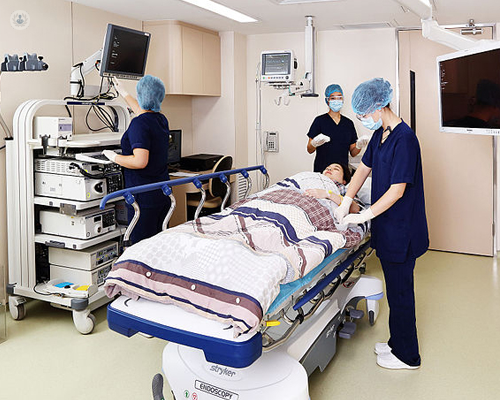Endoscopic mucosal resection (EMR)
Dr Amit Gera - Gastroenterology
Created on: 04-13-2018
Updated on: 09-29-2023
Edited by: Lauren Dempsey
What is endoscopic mucosal resection?
Endoscopic mucosal resection (EMR) is a minimally-invasive technique used to remove precancerous growths, early-stage cancer, and other abnormal lesions from the lining of the digestive system.

Why would you have endoscopic mucosal resection?
EMR is used to remove early-stage cancer or other abnormalities in the digestive tract lining. It can also be used to take tissue samples (a biopsy) to help the doctor diagnose the problem, and if the patient has cancer, EMR can help the doctor to know if the cancer has spread to the digestive tract.
Some conditions endoscopic mucosal resection can be used to treat include:
- Barrett’s oesophagus
- early oesophageal cancer
- stomach cancer
- cancer of the small intestine
- polyps in the colon
- colorectal cancer
- noncancerous growths in the uterus (leiomyomas, or fibroids)
How can I prepare for endoscopic mucosal resection?
You will have to provide your medical history and details of any medication you use to the doctor before having EMR. You will be instructed not to eat or drink anything from several hours before the procedure, and you may not be able to take certain medication during this time either, as it may interfere with the sedatives you will be given.
How is an endoscopic mucosal resection performed?
Patients will be given a sedative to prevent pain, the strength of which depends on the patient and procedure. EMR may be performed from the upper or lower end of the digestive tract, depending on the location of the cancer or growth. For an EMR of the upper digestive tract, a local anaesthetic will be delivered via a spray to numb the throat and oesophagus.
A long, narrow tube fitted with a light and video camera, called an endoscope, is inserted into either the mouth (to reach the oesophagus, stomach, or upper part of the small intestine) or the anus (to examine the colon). To remove tissue, the doctor inserts instruments through the endoscope.

What are the benefits of an endoscopic mucosal resection?
Endoscopic mucosal resection is a less-invasive option than open surgery and can be the safest option to remove cancers. The organs remain in place, so the patient’s quality of life isn’t affected. There is also a very low reoccurrence rate of the cancer in patients who undergo an EMR, if the cancer is in the early stages or hasn’t spread to other parts of the body.
What are some potential complications from endoscopic mucosal resection to be aware of?
Like any operation, there are risks to be aware of. Bleeding can occur, as well as tearing or narrowing of the oesophagus or stomach.
What is recovery following an endoscopic mucosal resection like?
The patient remains in the hospital until the effects of sedation have worn off. The doctor will provide instructions on when they can start eating and drinking again. While most patients go home on the same day, it is advised that someone takes them home, as it is not advisable to drive. A follow-up appointment will be made to discuss the results of the EMR, and after several months another endoscopy will be performed to ensure the whole lesion is gone.
